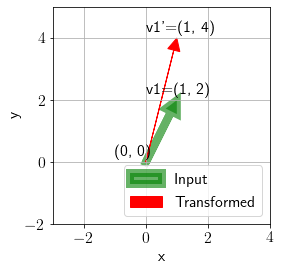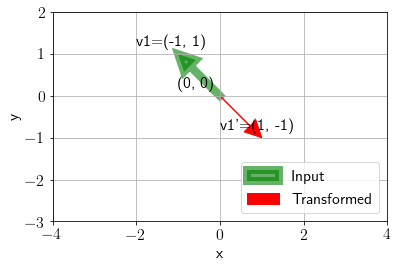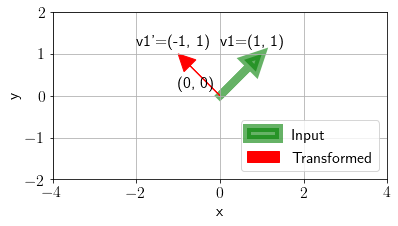Positive definiteness
Positive definiteness¶
Author: Nipun Batra, Zeel B Patel
In this notebook, we will try and understand the notion of positive definitiveness and positive semi-definitiveness. We will be referring an excellent video from 3Blue1Brown: https://youtu.be/kYB8IZa5AuE
The main concepts in this notebook are:
Matrix vector product as linear transformation
Vector dot product
import numpy as np
import matplotlib.pyplot as plt
from matplotlib import rc
from matplotlib.animation import FuncAnimation
rc('font', size=16)
rc('text', usetex=True)
rc('animation', html='jshtml')
Let us take a vector \(\mathbf{v}_1 = [1\;\;\;2]^T\)
v1 = np.array([1, 2]).reshape(-1,1)
plt.arrow(x=0, y=0, dx=v1[0,0], dy=v1[1,0], shape='full', head_width=0.2, head_length=0.2, length_includes_head=True)
plt.text(0-0.2, 0+0.2, f'({0}, {0})')
plt.text(v1[0,0]-0.2, v1[1,0]+0.2, f'({v1[0,0]}, {v1[1,0]})')
plt.scatter(0, 0)
plt.grid()
plt.ylim((-1, 3))
plt.xlim(-1, 3);
plt.xlabel('x');plt.ylabel('y');
plt.title('$\mathbf{v}_1 = '+f'[{v1[0,0]}\;\;\;{v1[1,0]}]$');

We define a transformation matrix \(A\) as below.
A = np.array([[1, 0], [0, 2]])
def plot_transformation(x, A, ax, annotate=False):
arrow_in = ax.arrow(x=0, y=0, dx=x[0, 0], dy=x[1, 0], shape='full', head_width=0.4,
head_length=0.4, color='green', lw=8, alpha=0.6, length_includes_head=True)
ax.grid()
# Applying transformation
Ax = A@x
# Get current min, max
ymin, ymax = (min(Ax[1], x[1], 0)-2, max(Ax[1], x[1], 0)+1)
xmin, xmax = (min(Ax[0], x[0], 0)-3, max(Ax[0], x[0], 0)+3)
# Check and update according to previous
ax.set_ylim(min(ymin, ax.set_ylim()[0]), max(ymax, ax.set_ylim()[1]))
ax.set_xlim(min(xmin, ax.set_xlim()[0]), max(xmax, ax.set_xlim()[1]))
arrow_out = ax.arrow(x=0, y=0, dx=Ax[0, 0], dy=Ax[1, 0], shape='full', head_width=0.4,
head_length=0.4, color='red', length_includes_head=True)
if annotate:
ax.text(0-1, 0+0.2, f'({0}, {0})')
ax.text(x[0, 0]-1, x[1, 0]+0.2, f'v1=({x[0, 0]}, {x[1, 0]})')
ax.text(Ax[0, 0]-1, Ax[1, 0]+0.2, f'v1\'=({Ax[0, 0]}, {Ax[1, 0]})')
ax.legend([arrow_in, arrow_out, ], ['Input','Transformed',], loc='lower right')
ax.set_aspect('equal')
ax.set_xlabel('x');ax.set_ylabel('y')
return Ax
Plotting the transformation.
fig, ax = plt.subplots()
Av = plot_transformation(v1, A, ax, annotate=True)

Let us now look at a different input and a different transformation.
v1 = np.array([-1, 1]).reshape(-1, 1)
A = np.array([[1, 2], [2, 1]])
fig, ax = plt.subplots()
Av = plot_transformation(v1, A, ax, annotate=True)

For the above transformation, it seems that the angle is 180 degrees
v1 = np.array([1, 1]).reshape(-1,1)
A = np.array([[0, -1], [1, 0]])
fig, ax = plt.subplots()
Av = plot_transformation(v1, A, ax, annotate=True)

def plot_full(v1, A, ax, annotate=False):
plot_transformation(v1, A, ax, annotate=annotate)
vAv = v1.T@A@v1
ax.set_title('$\mathbf{v}^TA\mathbf{v} = '+f'{vAv[0,0]}$')
Let us visualize transformations for the following \(A\) and check the direction of the transformation.
A = np.array([[1, 0], [0, 1]])
fig, ax = plt.subplots()
def update(x):
i, j = x
ax.cla()
plot_full(np.array([-i, j]).reshape(-1,1), A, ax)
ax.set_xlim(-6,6)
ax.set_ylim(-10,6)
frames = []
for i in range(-5, 5, 1):
for j in range(-5, 5, 1):
frames.append((i, j))
plt.tight_layout()
anim = FuncAnimation(fig, update, frames)
plt.close()
anim
We can see that \(\mathbf{v}^TA\mathbf{v}\) is non-negative in any case and also eigen values of \(A\) are positive
Now, we modify \(A\) to the following,
A = np.array([[1, 0], [0, -1]])
fig, ax = plt.subplots()
def update(x):
i, j = x
ax.cla()
plot_full(np.array([-i, j]).reshape(-1,1), A, ax)
ax.set_xlim(-6,6)
ax.set_ylim(-10,6)
frames = []
for i in range(-5, 5, 1):
for j in range(-5, 5, 1):
frames.append((i, j))
plt.tight_layout()
anim = FuncAnimation(fig, update, frames)
plt.close()
anim
We can see that \(\mathbf{v}^TA\mathbf{v}\) is negative in some cases and also one of the eigen values of \(A\) is negative.
Let us try one more value of \(A\) to draw more insights.
A = np.array([[1, -1], [0, 2]])
fig, ax = plt.subplots()
def update(x):
i, j = x
ax.cla()
plot_full(np.array([-i, j]).reshape(-1,1), A, ax)
ax.set_xlim(-6,6)
ax.set_ylim(-10,6)
frames = []
for i in range(-5, 5, 1):
for j in range(-5, 5, 1):
frames.append((i, j))
plt.tight_layout()
anim = FuncAnimation(fig, update, frames)
plt.close()
anim
What common behaviour is observed in the above behaviour?
If all eigen values of \(A\) are non-negative, \(\mathbf{v}^TA\mathbf{v}\) is also non-negative for any \(\mathbf{v}\). In this case, \(A\) is positive semi definite.
If any eigen value of \(A\) is negative, \(\mathbf{v}^TA\mathbf{v}\) is also negative for some \(\mathbf{v}\). In this case, \(A\) is not positive semi definite.
Why non negative eigen values: https://math.stackexchange.com/questions/1404534/why-does-positive-definite-matrix-have-strictly-positive-eigenvalue
